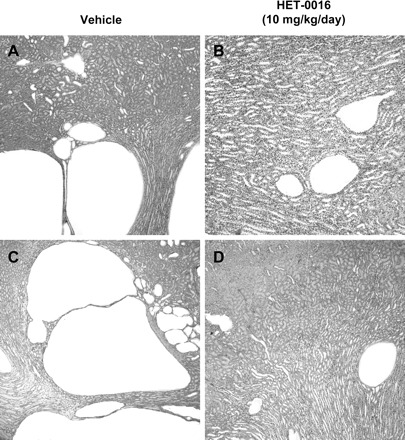Volume 296, March 2009
Volume 65, March 2009
Pages F575–F582. Park F, Sweeney WE Jr, Jia G, Akbulut T, Mueller B, Falck JR, Birudaraju S, Roman RJ, Avner ED. Chronic blockade of 20-HETE synthesis reduces polycystic kidney disease in an orthologous rat model of ARPKD. Am J Physiol Renal Physiol 296: F575–F582, 2009 (doi:10.1152/ajprenal.90705.2008). On p. F579, Fig. 2C is a histological section from the same vehicle-treated polycystic kidney disease (PCK) rat kidney as shown in Fig. 2A. This inadvertant duplication has now been removed and replaced with a new image from another vehicle-treated PCK rat kidney at the same magnification. The results and conclusions in the manuscript were not affected by this error, and the authors sincerely apologize for the error. The revised version of Fig. 2 and the legend are shown below.
Fig. 2.

Effect of 20-HETE synthesis inhibition on kidney mass in a rat model of autosomal recessive polycystic kidney disease (ARPKD). HET-0016 (10 mg·kg–1·day–1), a specific inhibitor of 20-HETE synthesis, was administered daily to polycystic kidney (PCK) rats into the intraperitoneal space, and the animals were killed between postnatal days 56 and 63. The kidneys were harvested, fixed in plastic, and sectioned. Representative kidney sections from four different rats treated with either vehicle (A and C) or HET-0016 (B and D) are shown. Sections were stained with hematoxylin; n = 4 kidneys/group. Magnification ×20.


